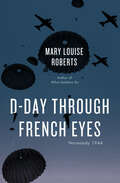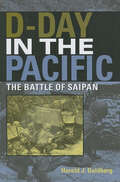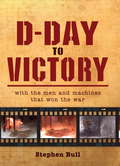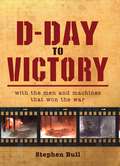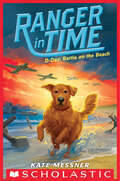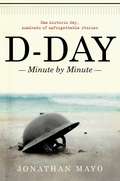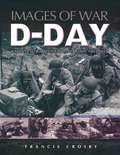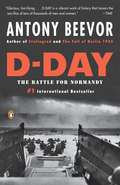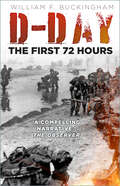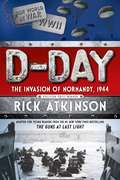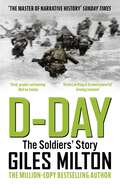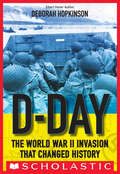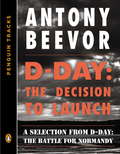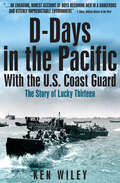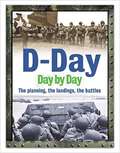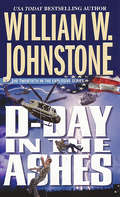- Table View
- List View
D-Day Through French Eyes: Normandy 1944
by Mary Louise Roberts&“A moving examination of how French civilians experienced the fighting&” at Normandy during WWII from the acclaimed author of What Soldiers Do (Telegraph, UK). &“Like big black umbrellas, they rain down on the fields across the way, and then disappear behind the black line of the hedges.&” Silent parachutes dotting the night sky—that&’s how one Normandy woman learned that the D-Day invasion was under way in June of 1944. Though they yearned for liberation, the French had to steel themselves for war, knowing that their homes, lands, and fellow citizens would have to bear the brunt of the attack. With D-Day through French Eyes, Mary Louise Roberts turns the conventional narrative of D-Day on its head, taking readers across the Channel to view the invasion anew. Roberts builds her history from an impressive range of gripping first-person accounts by French citizens throughout the region. A farm family notices that cabbage is missing from their garden—then discovers that the guilty culprits are American paratroopers hiding in the cowshed. Fishermen rescue pilots from the wreck of their B-17, then search for clothes big enough to disguise them as civilians. A young man learns to determine whether a bomb is whistling overhead or silently plummeting toward them. When the allied infantry arrived, French citizens guided them to hidden paths and little-known bridges, giving them crucial advantages over the German occupiers. As she did in her acclaimed account of GIs in postwar France, What Soldiers Do, Roberts here sheds vital new light on a story we thought we knew. "In the great tradition of Studs Terkel and Is Paris Burning?, Mary Louise Roberts uses the diaries and memoirs of French civilians to narrate a history of the French at D-Day that has for too long been occluded by the mythology of the allied landing.&”—Alice Kaplan, author of Dreaming in French
D-Day To Berlin
by Andrew WilliamsNightfall, 6 June 1944. D-Day is over and the Allies have carved a tenuous foothold in 'Fortress Europe'. The future of Europe hangs in the balance as Hitler's formidable SS Panzer troops threaten to drive them back into the sea. D-Day to Berlin is the remarkable story of the Allied struggle for survival - the battle from the beaches of Normandy to the heart of Hitler's Reich and ultimate victory just eleven months later. The campaign to free Europe from Nazi oppression through the collective operations from D-Day to Berlin mark one of the greatest ever military offensives. The Allies overcame initial setbacks to inflict a devastating defeat on Hitler's crack divisions in France - a victory that was threatened just months later in the bitter winter fighting of the Battle of the Bulge. The final crossing of the Rhine and the advance into Germany changed the course of European history forever. In D-Day to Berlin we meet men and women from both sides - British, American and German soldiers - whose bravery and endurance made the final push through Europe the defining drama of the Second World War.
D-Day To Berlin
by Andrew WilliamsNightfall, 6 June 1944. D-Day is over and the Allies have carved a tenuous foothold in 'Fortress Europe'. The future of Europe hangs in the balance as Hitler's formidable SS Panzer troops threaten to drive them back into the sea. D-Day to Berlin is the remarkable story of the Allied struggle for survival - the battle from the beaches of Normandy to the heart of Hitler's Reich and ultimate victory just eleven months later. The campaign to free Europe from Nazi oppression through the collective operations from D-Day to Berlin mark one of the greatest ever military offensives. The Allies overcame initial setbacks to inflict a devastating defeat on Hitler's crack divisions in France - a victory that was threatened just months later in the bitter winter fighting of the Battle of the Bulge. The final crossing of the Rhine and the advance into Germany changed the course of European history forever. In D-Day to Berlin we meet men and women from both sides - British, American and German soldiers - whose bravery and endurance made the final push through Europe the defining drama of the Second World War.
D-Day in the Pacific: The Battle of Saipan (Twentieth-Century Battles)
by Harold J. Goldberg“The narrative moves smoothly and crisply. There is effective treatment of strategy, preparations, and then the invasion and battle for Saipan itself.” —Spencer C. Tucker, author of American RevolutionIn June 1944 the attention of the nation was riveted on events unfolding in France. But in the Pacific, the Battle of Saipan was of extreme strategic importance. This is a gripping account of one of the most dramatic engagements of World War II. The conquest of Saipan and the neighboring island of Tinian was a turning point in the war in the Pacific as it made the American victory against Japan inevitable. Until this battle, the Japanese continued to believe that success in the war remained possible. While Japan had suffered serious setbacks as early as the Battle of Midway in 1942, Saipan was part of her inner defense line, so victory was essential. The American victory at Saipan forced Japan to begin considering the reality of defeat. For the Americans, the capture of Saipan meant secure air bases for the new B-29s that were now within striking distance of all Japanese cities, including Tokyo.“Harold Goldberg’s riveting story of this conflict brings the dead back to life by blending rigorous research with dramatic narratives by hundreds of survivors. He has written a superb account of a pivotal, little-known, and heart-breaking battle.” —Col. Joseph H. Alexander, USMC (ret.),author of Storm Landings“Using recent interviews he conducted with extant US veterans, [Goldberg] skillfully develops the soldiers’ view of the battle for Saipan in an engaging, clearly written and interesting volume.” —The Journal of Military History
D-Day to Victory
by Stephen Bull Impossible PicturesBeginning with a look at D-Day itself, this book begins by analyzing the deadly fighting on the beaches as the Allies launched the first successful cross-Channel invasion in 900 years and concludes with the final victory amidst the ruins of Berlin. Now, almost 70 years afterwards, this book reveals the realities of the final year of the war through the words and recollections of the last surviving veterans. Using their own words and accounts it describes the terror of soldiers facing down a German tank, assaulting a machine-gun post or surviving an artillery barrage on the long, arduous road to Victory-in-Europe. Drawing upon expert analysis and no-holds-barred recreations, it also shows the devastating effects of the weaponry used on a daily basis in an astonishing sequence of full-colour images while historic imagery bring to life the last great battles between the Allies and Nazi Germany from the torturous struggle for control of Falaise to the desperate fighting in the Bulge and the final push to the heart of the Reich. Like no other book before, World War II Frontline Heroes, reveals how ordinary men and women fought and survived throughout the extraordinary final months of World War II.
D-Day to Victory
by Stephen BullAn eye-popping, innovative approach to one of the most-popular topics in all of history: the European Theater of World War II. The myth-busting designers of this unique book will provide readers with a full account of the campaign to liberate Europe sprinkled throughout with more than 200 unequalled visual assets. Based-on the 6-part mini-series coming from BBC Channel 4 in the UK and History TV in Canada. Includes extensive interviews with WWII veterans such as Col. Edward D. Shames who fought with the legendary 'Band of Brothers' of "E" Company, 2/506, 101st Airborne.
D-Day with the Screaming Eagles
by George KoskimakiA collection of eyewitness accounts of the Normandy landings that &“gives you the [feeling] that you are there during the frenzied first hours of the invasion&” (Kepler&’s Military History Book Reviews). Many professional historians have recorded the actions of D-Day but here is an account of the airborne actions as described by the actual men themselves, in eyewitness detail. Participants range from division command personnel to regimental, battalion, company, and battery commanders, to chaplains, surgeons, enlisted medics, platoon sergeants, squad leaders and the rough, tough troopers who adapted quickly to fighting in mixed, unfamiliar groups after a badly scattered drop. And yet they managed to gain the objectives set for them in the hedgerow country of Normandy. This book is primary source material. It is a &“must read&” for anyone interested in the Normandy landings, the 101st Airborne Division, and World War II in general. Hearing the soldiers speak is an entirely different experience from reading about the action in a narrative history.
D-Day, Arnhem & the Rhine: A Glider Pilot’s Memoir
by Robert F. AshbyFoot soldiers, commandos, parachutists, naval seamen, bomber and fighter pilots – their varied personal experiences of the Second World War have been widely recounted, and the parts they played in the conflict are well known. But there are specialized wartime roles that have received very little attention, notably the gallant actions of the men of the Glider Pilot Regiment. That is why Robert Ashby’s rare and vivid pilot’s memoir is so valua-ble. In it he offers a fascinating insight not only into the major operations he took part in – including D-Day, Arnhem and the Rhine crossing – but into the exacting flying skills required to carry out perilous glider landings on enemy territory while under fire. His account of his hair-raising training, together with his pen-portraits of his comrades and officers, takes the reader inside the world of a ‘citizen soldier’. The glider landings at Arnhem and the intense fighting that followed are the climax of his narrative, offering us a remarkable insight into one of the most controversial Allied disasters of the entire war.
D-Day: Battle On The Beach (Ranger in Time #7)
by Kate MessnerIn this historical adventure novel for middle grade readers, a dog travels through time to join the allied forces in the Battle of Normandy.Ranger, the time-traveling golden retriever with search and rescue skills, heads to Normandy on the morning of the D-Day invasion and finds himself in the middle of one of the fiercest battles of World War II. Ranger meets Leo, a Jewish boy who is hiding with a local farmer, and Walt, a young African-American soldier fighting to free France from the Nazis. It’s pure chaos, with thundering warplanes, falling bombs, and exploding land mines. Will Ranger, Leo, and Walt survive?
D-Day: June 6, 1944: The Climactic Battle of World War II (Core Ser.)
by Stephen E. Ambrose<p>Stephen E. Ambrose draws from more than 1,400 interviews with American, British, Canadian, French, and German veterans to create the preeminent chronicle of the most important day in the twentieth century. Ambrose reveals how the original plans for the invasion were abandoned, and how ordinary soldiers and officers acted on their own initiative. <p><i>D-Day</i> is above all the epic story of men at the most demanding moment of their existence, when the horrors, complexities, and triumphs of life are laid bare. Ambrose portrays the faces of courage and heroism, fear and determination -- what Eisenhower called "the fury of an aroused democracy" -- that shaped the victory of the citizen soldiers whom Hitler had disparaged.</p>
D-Day: Juno Beach, Canada's 24 Hours of Destiny
by Lance GoddardMany have called it the most important event of the twentieth century - and Canada played a key role. When Canadian troops landed at Juno Beach, they faced some of the fiercest opposition of the attack, and yet they managed to advance further inland than all the other Allied forces. D-Day: Juno Beach, Canada’s 24 Hours of Destiny chronicles that momentous day hour-by-hour, through the words of the men themselves. With more than 300 illustrations, this is a vivid remembrance of one of Canada’s greatest military achievements.
D-Day: Minute by Minute
by Jonathan Mayo<p>Told in a purely chronological style, this fascinating account vividly details the authentic stories of regular people caught up in the historical events of D-Day. <p>June 6, 1944 was a truly historic day, but it was also a day where ordinary people found themselves in extraordinary situations... Lieutenant Norman Poole jumped from a bomber surrounded by two hundred decoy dummy parachutists. French baker Pierre Cardron led British paratroopers to his local church, where he knew two German soldiers were hiding in the confessional. Southampton telegram boy Tom Hiett delivered his first "death message" by midday. At the sound of Allied aircraft, Werner Kortenhaus of the twenty-first Panzer Division ran to collect his still damp washing from a French laundrywoman. And injured soldiers wept in their beds in a New York hospital, knowing that their buddies lay dying on the Normandy beaches. <p>Drawing on memoirs, diaries, letters, and oral accounts, <i>D-Day</i> is a purely chronological narrative, concerned less with the military strategies and more with what people were thinking and doing as D-Day unfolded, minute-by-minute. Moving seamlessly from various perspectives and stories, <i>D-Day</i> sets the reader in the midst of it all, compelling us to relive this momentous day in world history.</p>
D-Day: Minute by Minute
by Jonathan MayoTold in a purely chronological style, this fascinating account vividly details the authentic stories of regular people caught up in the historical events of D-Day.June 6, 1944 was a truly historic day, but it was also a day where ordinary people found themselves in extraordinary situations... Lieutenant Norman Poole jumped from a bomber surrounded by two hundred decoy dummy parachutists. French baker Pierre Cardron led British paratroopers to his local church, where he knew two German soldiers were hiding in the confessional. Southampton telegram boy Tom Hiett delivered his first "death message" by midday. At the sound of Allied aircraft, Werner Kortenhaus of the twenty-first Panzer Division ran to collect his still damp washing from a French laundrywoman. And injured soldiers wept in their beds in a New York hospital, knowing that their buddies lay dying on the Normandy beaches. Drawing on memoirs, diaries, letters, and oral accounts, D-Day is a purely chronological narrative, concerned less with the military strategies and more with what people were thinking and doing as D-Day unfolded, minute-by-minute. Moving seamlessly from various perspectives and stories, D-Day sets the reader in the midst of it all, compelling us to relive this momentous day in world history.
D-Day: Rare Photographs from Wartime Archives (Images of War)
by Francis CrosbyPersonal accounts of D-Day drawn from newly available WWII archives share the experiences of aerial, land, and naval troops—includes photos. On June 6, 1944, an Allied force of American, British, and Canadian troops stormed the beaches of Normandy, France, and turned the tide against the occupying Nazi army. Harrowing and heroic, the events of D-Day were recorded in the personal writings of those who were there. Here, Francis Crosby has compiled a comprehensive collection of previously unpublished letters, diaries, photographs, and reminiscences that tell the story of D-Day as it has never been told before. With the use of new international archives, Crosby has culled vivid and detailed eye-witness accounts from each beach, as well as perspectives from land, sea, and air. This fascinating collection includes entries from American, British, and Canadian troops, the Merchant Navy and the Royal Air Force, and newly available German materials. Also included are contemporary and retrospective reactions of women &“in the know&” and those whom knew from &“unofficial sources&” of the immediate imminence of the assault.
D-Day: The Battle for Normandy (Litterature & Documents Ser.)
by Antony Beevor<p>Renowned historian Antony Beevor, author of <i>Stalingrad</i> and <i>The Battle of Arnhem</i>, and the man who "single-handedly transformed the reputation of military history" (The Guardian) presents the first major account in more than twenty years of the Normandy invasion and the liberation of Paris. <p>This is the first book to describe not only the experiences of the American, British, Canadian, and German soldiers, but also the terrible suffering of the French caught up in the fighting. Beevor draws upon his research in more than thirty archives in six countries, going back to original accounts and interviews conducted by combat historians just after the action. <p><i>D-Day</i> is the consummate account of the invasion and the ferocious offensive that led to Paris's liberation.</p>
D-Day: The First 72 Hours
by William F Buckingham William F. BuckinghamThe Allied invasion of occupied France began by delivering three airborne and six infantry divisions onto a 60-mile stretch of the Normandy coast. Accomplishing this involved over 1,200 transport aircraft, 450 gliders, 325 assorted warships and more than 4,000 landing vessels. The first 72 hours of the D-Day invasion were pivotal – from the initial airborne landings in the early hours of Tuesday 6 June 1944 we follow the Allied attackers and their German opponents hour-by-hour as they fought until fresh units began to take over from Thursday 8 June 1944.William F. Buckingham’s astounding history finally lays to rest the myths surrounding the Normandy invasion. He contradicts the popular perception that the American OMAHA landing force suffered disproportionately. In fact, the fighting on the British and Canadian beaches (GOLD, SWORD and JUNO) was no less intense, and the cost was much closer to that of OMAHA than is commonly thought. The reality of D-Day was that a devastating number of men from all sides of the Allied forces who landed on the beaches that day would never set foot on their native soil again.
D-Day: The Invasion Of Normandy, 1944
by Rick AtkinsonAdapted for young readers from the #1 New York Times–bestselling The Guns at Last Light, D-Day captures the events and the spirit of that day—June 6, 1944—the day that led to the liberation of western Europe from Nazi Germany's control. They came by sea and by sky to reclaim freedom from the occupying Germans, turning the tide of World War II. Atkinson skillfully guides his younger audience through the events leading up to, and of, the momentous day in this photo-illustrated adaptation. Perfect for history buffs and newcomers to the topic alike! <p><p> This thoroughly-researched and documented book can be worked into multiple aspects of the common core curriculum.
D-Day: The Soldiers' Story
by Giles Milton'Compellingly authentic, revelatory and beautifully written. A gripping tour de force' Damien LewisAlmost seventy-five years have passed since D-Day, the day of the greatest seaborne invasion in history. The outcome of the Second World War hung in the balance on that chill June morning. If Allied forces succeeded in gaining a foothold in northern France, the road to victory would be open. But if the Allies could be driven back into the sea, the invasion would be stalled for years, perhaps forever.An epic battle that involved 156,000 men, 7,000 ships and 20,000 armoured vehicles, the desperate struggle that unfolded on 6 June 1944 was, above all, a story of individual heroics - of men who were driven to keep fighting until the German defences were smashed and the precarious beachheads secured. Their authentic human story - Allied, German, French - has never fully been told.Giles Milton's bold new history narrates the day's events through the tales of survivors from all sides: the teenage Allied conscript, the crack German defender, the French resistance fighter. From the military architects at Supreme Headquarters to the young schoolboy in the Wehrmacht's bunkers, D-Day: The Soldiers' Story lays bare the absolute terror of those trapped in the frontline of Operation Overlord. It also gives voice to those hitherto unheard - the French butcher's daughter, the Panzer Commander's wife, the chauffeur to the General Staff.This vast canvas of human bravado reveals 'the longest day' as never before - less as a masterpiece of strategic planning than a day on which thousands of scared young men found themselves staring death in the face. It is drawn in its entirety from the raw, unvarnished experiences of those who were there.(P)2018 Hodder & Stoughton Limited
D-Day: The Soldiers' Story / 'Vivid, graphic and moving' Mail on Sunday
by Giles Milton'Vivid, graphic and moving' Mail on Sunday Book of the Year'It has a wonderful immediacy and vitality - living history in every sense' Anthony Horowitz'Fantastic' Dan Snow'Compellingly authentic, revelatory and beautifully written. A gripping tour deforce' Damien Lewis'Stirring and unsettling in equal measure, this is history writing at its most powerful' Evening StandardSeventy-five years have passed since D-Day, the day of the greatest seaborne invasion in history.The outcome of the Second World War hung in the balance on that chill June morning. If Allied forces succeeded in gaining a foothold in northern France, the road to victory would be open. But if the Allies could be driven back into the sea, the invasion would be stalled for years, perhaps forever.An epic battle that involved 156,000 men, 7,000 ships and 20,000 armoured vehicles, the desperate struggle that unfolded on 6 June 1944 was, above all, a story of individual heroics - of men who were driven to keep fighting until the German defences were smashed and the precarious beachheads secured. Their authentic human story - Allied, German, French - has never fully been told.Giles Milton's bold new history narrates the day's events through the tales of survivors from all sides: the teenage Allied conscript, the crack German defender, the French resistance fighter. From the military architects at Supreme Headquarters to the young schoolboy in the Wehrmacht's bunkers, D-Day: The Soldiers' Story lays bare the absolute terror of those trapped in the frontline of Operation Overlord. It also gives voice to those hitherto unheard - the French butcher's daughter, the Panzer Commander's wife, the chauffeur to the General Staff.This vast canvas of human bravado reveals 'the longest day' as never before - less as a masterpiece of strategic planning than a day on which thousands of scared young men found themselves staring death in the face. It is drawn in its entirety from the raw, unvarnished experiences of those who were there.
D-Day: The World War II Invasion That Changed History (Scholastic Focus)
by Deborah HopkinsonSibert Honor author Deborah Hopkinson brings her signature research and action-packed narrative style to one of the most crucial battles of WWII.Scholastic Focus is the premier home of thoroughly researched, beautifully written, and thoughtfully designed works of narrative nonfiction aimed at middle-grade and young adult readers. These books help readers learn about the world in which they live and develop their critical thinking skills so that they may become dynamic citizens who are able to analyze and understand our past, participate in essential discussions about our present, and work to grow and build our future.The WWII invasion known as D-Day was the largest military endeavor in history. By June 6, 1944, Hitler and his allies had a strong grip on the European continent, where Nazi Germany was engaged in the mass extermination of the Jewish people. The goal of D-Day was the total defeat of Hitler's regime, and the defense of free democracies everywhere. Knowing they had to breach the French coast, the US, Great Britain, and Canada planned for the impossible.D-Day was an invasion not for conquest, but liberation, and required years to plan and total secrecy to keep the advantage of surprise. Once deployed, Operation Overlord involved soldiers, sailors, paratroopers, and specialists. Acclaimed author Deborah Hopkinson weaves together the contributions of not only D-Day's famous players, but African Americans, women, journalists, and service members in a masterful tapestry of official documents, personal narratives, and archival photos to bring this decisive battle to vivid, thrilling life.
D-Day: The battle for Normandy
by Antony BeevorThe little-known drama of the last-minute decision to launch the invasion of Normandy--excerpted from the internationally bestselling D-Day: The Battle for Normandy In D-Day: The Decision to Launch, excerpted from Antony Beevor's bestselling book D-Day: The Battle for Normandy, readers get the little-known story of how the difficult decision was made to launch the Allied invasion of France on June 6, 1944. The stakes could not have been higher: if Operation Overlord were to fail, it would be a crushing blow to the Allies, a huge loss of both men and equipment. The decision of when to launch rested with supreme commander General Dwight D. Eisenhower, but it hinged on one factor: the weather. If there was too much cloud cover, the Allied bombers wouldn't be able to provide air support, and if the seas were too rough, the landing craft would be swamped. It fell to one man to predict the weather: Dr. James Stagg, the head of the meteorological team at Supreme Headquarters Allied Expeditionary Force. This riveting selection from D-Day, praised by Time as "a vibrant work of history that honors the sacrifice of tens of thousands of men and women," tells the fascinating inside story of one of the most important decisions of World War II.
D-Days in the Pacific
by Donald L. MillerAlthough most people associate the term D-Day with the Normandy invasion on June 6, 1944, it is military code for the beginning of any offensive operation. In the Pacific theater during World War II there were more than one hundred D-Days. The largest—and last—was the invasion of Okinawa on April 1, 1945, which brought together the biggest invasion fleet ever assembled, far larger than that engaged in the Normandy invasion.D-Days in the Pacific tells the epic story of the campaign waged by American forces to win back the Pacific islands from Japan. Based on eyewitness accounts by the combatants, it covers the entire Pacific struggle from the attack on Pearl Harbor to the dropping of atomic bombs on Hiroshima and Nagasaki. The Pacific war was largely a seaborne offensive fought over immense distances. Many of the amphibious assaults on Japanese-held islands were among the most savagely fought battles in American history: Guadalcanal, Tarawa, Saipan, New Guinea, Peleliu, Leyte Gulf, Iwo Jima, Okinawa. Generously illustrated with photographs and maps, D-Days in the Pacific is the finest one-volume account of this titanic struggle.
D-Days in the Pacific With the US Coastguard: The Story of Lucky Thirteen
by Ken WileyAn award-winning, personal account of US amphibious operations in WWII by a veteran Coast Guardsman—illustrated with photographs and drawings.During World War II, Ken Wiley was a Coast Guardsman on an attack transport in the Pacific. In this work of historical memoir, Wiley relates the complex and often nerve-wracking story of how the United States projected its power across six thousand miles of ocean. Each invasion was a swirl of moving parts, from frogmen to fire support, transport mother ships to attack transports. In this vivid account, Wiley “brings the reader close to the experiences of another band of brothers,” from the camaraderie of young men facing unimaginable circumstances to the last terrifying stage when courageous soldiers stormed the beaches (Military Illustrated).Wiley participated in the campaigns for the Marshall Islands, the Marianas, the Philippines, and Okinawa. He recounts each with a precise eye for detail, relating numerous aspects of landing craft operations, such as ferrying wounded, that are often overlooked.Winner of the 2008 Foundation for Coast Guard History Book Award.
D-day Day By Day: The Planning, The Landings, The Battles
by Anthony HallThe hardcover reference titles in the Day by Day series examine the evolution of conflicts and wars in a chronological timeline, from the first skirmish to the last battle—and everything in between. These books are a historical companion to each major war in the nineteenth and twentieth century. The fate of soldiers, battalions, armies, can change in the blink of an eye—with this comprehensive book readers can follow the conflicting sides in their strategy, weaponry, and policies. D-Day: Day by Day is a chronological approach to the operation, allowing the reader to see at a glance the preparations made for the invasion of Normandy, as well as the key actions on the beaches and further inland. While the major actions dominate the text, eyewitness accounts and other stories are used to highlight actions of individual bravery and courage that, although they may not have been defining moments in the invasion, were an integral part of the overall effort, and provide an excellent guide to the human sacrifices made in order to achieve final victory. In addition to the blow-by-blow account of the action during these crucial days, the book features boxes on all the key personalities involved, including Eisenhower and Montgomery. There are also descriptions of the decisive weapons used by both the Allies and the Germans, and the key actions that were pivotal in the early days of the invasion.
D-day in the Ashes (Ashes #20)
by William W. JohnstonePost-apocalyptic patriots fight for freedom in a world ravaged by cannibal mutants in the New York Times–bestselling author&’s military sci-fi thriller. First the Liberals took all the guns. Then they took away the people&’s freedom. Now, Ben Raines and his patriot army are driving a weakened United States government into full-fledged retreat. Emerging as an unstoppable force, the Southern States are winning over one strategic ally after another, from the states in the American Northwest to the Canadian provinces—all wanting to be a part of a society based on law, justice, and old-fashioned values enforced by the barrel of a gun. But to be recognized by the world community, the Southern States of America must pay a price. The UN wants Ben Raines&’s warriors to play cops in a world overrun by criminals, gangs, and cannibalistic punks. Now, Raines and his army must engage in an all-out war of liberation across a crime-ravaged Europe, one bloody mile at a time . . . Twentieth in the long-running series!
